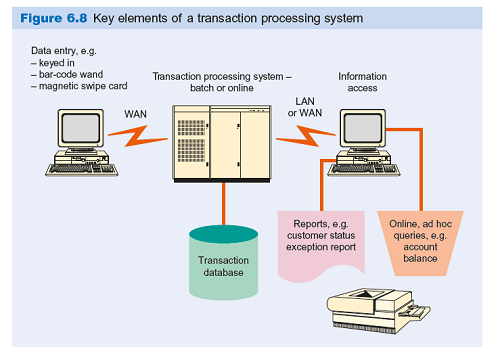Transaction processing systems (TPS) perform the frequent routine external and internal transactions that serve the operational level of the organisation. Examples of these transactions include:
- customers placing orders for products and services from a company, such as making a holiday booking
- a company placing orders with a supplier for components from which to make its products
- payment for goods or services received by a third party;
- a customer visiting a supermarket to shop (see the mini case study on retail applications of TPS by Sainsbury’s);
- a customer ringing a call centre of a bank to pay their bills;
- a withdrawal of money from an auto-teller machine (ATM)
Although the functions undertaken by the TPS are routine and repetitive, they usually perform a vital function in the organisation. Figure 6.8 shows the typical components of a transaction processing system. Data are usually input by being keyed in to on-screen data entry forms such as those used when orders are placed by phone. For retail applications, customer transactions are recorded through bar-code technology. Transactions will typically occur across a local-area network within a retail branch or bank environment, with real-time processing and data transfer occurring across a widearea network with a central mainframe computer. Sometimes data on transactions such as loyalty card purchases are stored locally in the supermarket on a local server in real time and then uploaded by a batch system (when the store is closed) to head office. This arrangement is shown in Figure 6.9. Other information such as supply requests may be transmitted on demand in real time.
There are two main types of transaction systems in operation. Batch systems, as the name suggests, collect information on transactions in batches before it is processed at times of lower transaction rates (such as overnight). Real-time systems process information immediately. Information from the transaction processing system is accessed in the branch and in the head office using online reporting, for example to find stock availability, or by offline
There are two main types of transaction systems in operation. Batch systems, as the name suggests, collect information on transactions in batches before it is processed at times of lower transaction rates (such as overnight). Real-time systems process information immediately. Information from the transaction processing system is accessed in the branch and in the head office using online reporting, for example to find stock availability, or by offline
reporting, where information is stored in a separate system for detailed analysis. This is the approach used for data warehouses, Because the TPS give direct contact with customers and suppliers beyond the boundary of an organisation, if they fail it becomes immediately apparent to the organisation’s customers (think about the consequences of a failure of an airline reservation system!). Therefore these are often mission-critical systems which must be reliable and secure. Another reason for such applications being mission-critical is that data captured by the TPS are used to monitor the performance of the organisation. The Sainsbury’s case study shows that for some organisations there will be many TPS in operation which have become essential to the needs of the organisation.


No comments:
Post a Comment